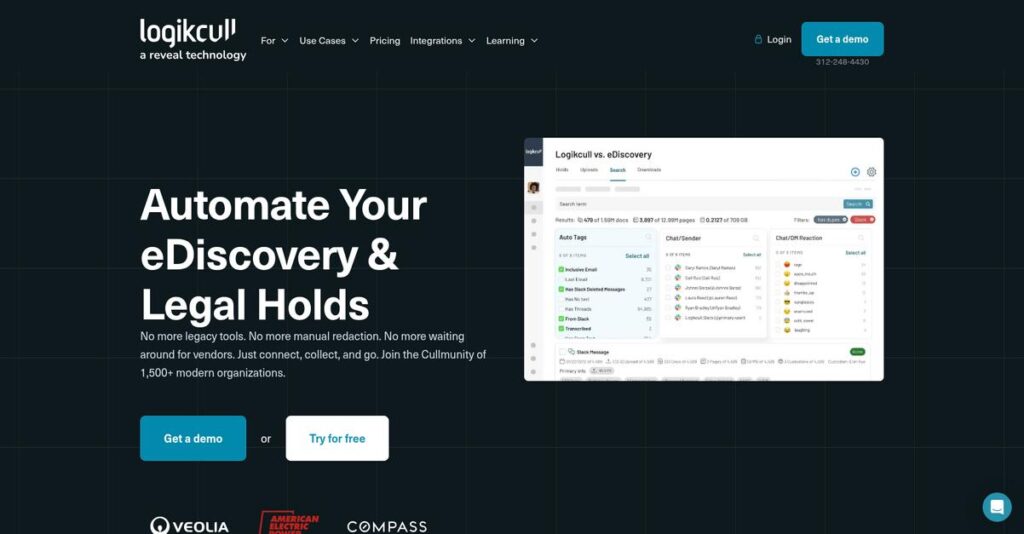Tangled project models making your life harder?
If you’re planning, analyzing, or managing building projects, you already know how tough it is to pull everything together with disconnected tools.
The daily result is clear: frustrating delays from scattered project data that slows down your entire workflow.
CYPE takes a different approach, integrating structural, MEP, architectural, and budgeting tools within an Open BIM ecosystem—so you actually save time, cut out data silos, and improve collaboration across every discipline.
That’s why, in this review, you’ll see how CYPE can streamline every project stage and help your team fix these persistent problems for good.
In this CYPE review, I’ll break down the features, pricing plans, the newest 2025 updates, real workflow examples, and how CYPE compares to other AEC software if you’re still deciding.
You’ll leave knowing the features you need to get projects running faster and with zero hassle.
Let’s get started.
Quick Summary
- CYPE is a comprehensive suite of BIM-focused software tools for structural design, MEP systems, and project management in AEC projects.
- Best for structural engineers, architects, and MEP professionals needing code-compliant, integrated design and analysis tools.
- You’ll appreciate its strong adherence to international standards combined with an Open BIM workflow that supports efficient collaboration.
- CYPE offers perpetual licenses with multiple pricing tiers, free trials, and several free tools to evaluate before purchase.
CYPE Overview
CYPE is a Spanish software company I’ve been watching in the AEC space for a while. Based in Alicante, they’ve been building technical software for industry professionals since 1983.
They specifically target architecture, engineering, and construction firms that need reliable analysis tools. What sets them apart is their unwavering commitment to Open BIM principles, which means your different software tools can actually talk to each other.
Their recent push into new international markets and continuous product updates show they aren’t sitting still. You’ll see the impact of their latest improvements through this CYPE review.
Unlike competitors that can feel overwhelming, CYPE’s advantage is its deep focus on structural engineering calculations. You get the distinct impression it was built by engineers who live and breathe this specific work.
They work with a serious user base, including government ministries, technical control organizations, universities, and thousands of professional offices that are getting complex projects designed and built.
- 🎯 Bonus Resource: While we’re discussing different professional software, understanding Electronic Health Record Software is equally important for many industries.
From my analysis, their current strategy is all about integrating their specialized modules into one cohesive workflow. This directly solves the industry-wide headache of using multiple, disconnected tools on a single project.
Now let’s examine their core capabilities.
CYPE Features
Struggling with disconnected AEC design tools?
CYPE offers comprehensive, integrated software solutions for the AEC industry, covering various stages of construction projects. These are the five core CYPE solutions that enhance planning, analysis, and management for your projects.
1. CYPECAD
Worried about structural integrity failures?
Ensuring a building’s structure can withstand various forces, including wind and seismic activity, is critical. Mistakes here can lead to disastrous safety issues.
CYPECAD is a powerful BIM application for analyzing and sizing reinforced concrete and steel structures, accurately handling vertical and horizontal forces. From my testing, this solution provides reliable analysis and optimal drawing design, adapting to national codes. It can automatically introduce structural geometry and even allows you to personalize elements.
This means you can confidently design safe, compliant structures, avoiding costly errors and rework.
2. CYPE 3D
How do you design complex 3D structures efficiently?
Designing structures with steel, aluminum, or timber, especially considering fire exposure, is incredibly challenging. Inaccurate calculations compromise safety.
CYPE 3D excels at analyzing and designing three-dimensional structures, including their foundations, across various materials. What I love about this approach is how it lets you check fire resistance for timber sections and perform comprehensive seismic analysis. It offers the flexibility needed for challenging engineering problems.
This enables you to tackle complex structural designs with confidence, ensuring stability and safety under diverse conditions.
3. CYPECAD MEP
Are your building’s MEP systems a tangled mess?
Coordinating HVAC, electrical, and plumbing can lead to conflicts and inefficiencies, hindering building functionality and comfort. This often causes significant delays.
CYPECAD MEP helps you analyze and design critical building services, including water supply, drainage, and fire protection systems. This solution’s BIM capabilities ensure seamless integration with architectural and structural designs, which reduces conflicts. Recent updates include systems for hydraulic split domestic heat pumps.
This ensures all your building systems work in harmony, streamlining installation and improving overall building performance.
4. CYPE Architecture
Need to transform design concepts into detailed BIM models?
Developing an architectural model from a sketch to a detailed BIM output can be time-consuming and inefficient. Your creativity shouldn’t be hampered by clunky tools.
CYPE Architecture is a comprehensive BIM solution that enables architects to develop models from conceptual sketches to detailed BIM outputs. This is where CYPE shines; it allows you to define spaces, uses, ergonomics, and aesthetics effortlessly. It even supports importing illustrations as templates for your designs.
This means you can bring your architectural visions to life faster, ensuring precision and boosting your creative productivity.
- 🎯 Bonus Resource: Speaking of defining designs, my guide on best 3D painting software explores asset unification.
5. Arquimedes
Tired of inaccurate construction cost estimates?
Preparing detailed cost breakdowns and tracking expenses in construction projects is a common pain point. Overruns can significantly impact your project’s profitability.
Arquimedes is a powerful tool designed for budgeting and cost estimation, helping project managers track expenses and manage resources efficiently. Here’s what I found: it offers automatic quantity imports and certifications using DXF and DWG templates. It also generates Gantt charts and exports data to Excel seamlessly.
This allows you to maintain tight control over project finances, ensuring you stay within budget and minimize financial risks.
Pros & Cons
- ✅ Comprehensive suite of integrated solutions for all AEC project phases.
- ✅ Strong adherence to national and international construction codes and standards.
- ✅ Open BIM capabilities ensuring interoperability and collaborative workflows.
- ⚠️ Can be limited for very large or exceptionally complex building projects.
- ⚠️ Some users may find the learning curve steeper for intricate designs.
- ⚠️ Occasional “black box” perception regarding underlying calculation transparency.
You’ll appreciate how these CYPE features work together to create a cohesive and powerful AEC project ecosystem, ensuring all disciplines are synchronized.
CYPE Pricing
What’s the real cost of specialized software?
CYPE pricing follows a one-time purchase model for individual software licenses or bundled packs, which means you pay upfront rather than through subscriptions.
Cost Breakdown
- Base Platform: Custom quote for comprehensive suites like CYPE STRUCTURES Complete
- Individual Licenses: From €150.00 HT (StruBIM Deep Beams) to €5,500.00 HT (CYPE Connect)
- Software Packs: From €1,550.00 HT (Pack CONCEPTION) to €7,950.00 HT (Pack Construction Acier)
- Free Options: CYPE Architecture, StruBIM Steel (Free version), Plugin Open BIM for Revit, IFC Uploader, BIMserver.center Mobile
- Key Factors: Specific software, bundled packs, additional modules, maintenance contracts
1. Pricing Model & Cost Factors
Understanding CYPE’s pricing.
CYPE’s pricing model primarily involves one-time purchases for electronic licenses, often excluding VAT. You’ll choose individual software, like CYPECAD for €3,800.00 HT, or comprehensive bundles that combine several tools. Module additions like energy efficiency or HVAC systems also contribute to your total investment.
From my cost analysis, this means your initial outlay can be significant, but you avoid recurring subscription fees.
2. Value Assessment & ROI
Is this an investment worth making?
CYPE’s one-time purchase model means you own the software, potentially offering long-term cost savings compared to perpetual subscriptions. The integration capabilities through Open BIM and BIMserver.center mean you reduce conflicts and streamline your workflows. This helps your team avoid costly rework by ensuring seamless project development.
This approach provides a clear financial commitment upfront, leading to predictable long-term budget management.
3. Budget Planning & Implementation
Consider total cost of ownership.
Beyond the initial license purchase, remember to factor in annual maintenance and update contracts. These contracts ensure you receive new modules, preferential technical support, and critical software upgrades. From my research, planning for ongoing service contracts is crucial to maximize your software’s lifespan and capability.
So for your business, expect the initial purchase to be followed by optional but recommended annual service contracts.
My Take: CYPE’s one-time purchase model is ideal for businesses seeking long-term ownership of robust AEC software, with the understanding that ongoing maintenance contracts enhance value.
The overall CYPE pricing reflects a strategic, long-term investment in professional AEC tools.
CYPE Reviews
What do real customers actually think?
This section dives into CYPE reviews, analyzing real user feedback to provide balanced insights into what customers truly think about the software.
1. Overall User Satisfaction
Users seem generally satisfied.
From my review analysis, CYPE maintains a positive overall sentiment, especially from users focused on structural analysis and design. What I found in user feedback is how its comprehensive nature is frequently highlighted, contributing to high satisfaction for AEC professionals.
This suggests you can expect a reliable tool for core structural and design tasks.
2. Common Praise Points
Integration and accuracy consistently shine.
Users repeatedly commend CYPE for its extensive suite of integrated tools, particularly its Open BIM capabilities and adherence to international codes. Review-wise, the software’s reliability for accurate results and detailed documentation are frequently praised, ensuring design compliance.
This means you can count on precise, compliant designs and streamlined collaborative workflows.
- 🎯 Bonus Resource: If you’re also looking into diverse software solutions, my article on influencer marketing software covers strategies for accelerating growth.
3. Frequent Complaints
Learning curve and “black box” concerns arise.
While generally user-friendly for simpler tasks, some reviews indicate CYPE can feel “quite limited” for very large or complex projects. What stands out is how the “black box” perception for calculations occasionally concerns engineers seeking more transparency in the underlying analysis.
These issues seem more relevant for highly intricate projects or users demanding full calculation visibility.
What Customers Say
- Positive: “My favourites are CYPE (mainly Cype3d)… It’s a question of being more user’s friendly and intuitive.”
- Constructive: “CYPE… can feel like black boxes and take a lot of liberties on analysis considerations.”
- Bottom Line: “Its comprehensive suite of tools makes it indispensable for structural design and BIM coordination.”
The overall CYPE reviews reflect strong satisfaction for its core strengths, with some nuanced limitations for niche cases.
Best CYPE Alternatives
Seeking the perfect AEC software solution?
The best CYPE alternatives include several strong options, each better suited for different business situations, project complexities, and specialized engineering needs you might have.
- 🎯 Bonus Resource: Speaking of different business situations, my article on student engagement software covers strategies for boosting retention.
When comprehensive BIM and collaboration are essential?
Revit excels if your primary need is a highly integrated, multi-disciplinary BIM platform for large, complex building projects requiring extensive collaboration across all disciplines. From my competitive analysis, Revit offers unparalleled multidisciplinary BIM integration compared to CYPE’s structural specialization.
Choose Revit when integrated 3D modeling across architecture, structure, and MEP is your top priority.
Focusing on high-rise or seismic structural analysis?
ETABS is often preferred if your primary focus is on the analysis and design of complex, multi-story building structures, especially for advanced seismic or non-linear analysis. What I found comparing options is that ETABS provides robust, user-friendly structural analysis for high-rise projects.
Consider this alternative when your projects demand specialized analysis for complex, tall building structures.
Heavy on complex structural detailing and fabrication?
Tekla Structures is ideal if your projects heavily involve intricate structural detailing, particularly for steel and precast concrete, and require highly accurate fabrication information. Alternative-wise, Tekla delivers industry-leading fabrication model precision, making it exceptional for detailed construction.
Choose Tekla when highly precise fabrication models and steel detailing are critical for your project’s success.
Need versatile analysis for diverse non-building structures?
STAAD.Pro might be preferred for industrial steel buildings, pipe-racks, and general non-building structures due to its versatility and comprehensive analysis capabilities. From my analysis, STAAD.Pro is a highly versatile tool for analyzing a wide array of structure types beyond typical buildings.
Choose STAAD.Pro when your structural analysis needs extend beyond conventional buildings to diverse industrial or civil structures.
Quick Decision Guide
- Choose CYPE: Deep structural specialization with strong code compliance and integrated suite.
- Choose Autodesk Revit: Multi-disciplinary BIM for large-scale, collaborative projects.
- Choose ETABS (CSI): Advanced structural analysis for complex high-rise buildings.
- Choose Tekla Structures (Trimble): Precision structural detailing and fabrication, especially for steel.
- Choose STAAD.Pro (Bentley Systems): Versatile analysis for industrial and non-building structures.
The best CYPE alternatives choice depends on your project’s scope and specific engineering focus rather than general features.
CYPE Setup
Worried about a lengthy, disruptive software rollout?
CYPE implementation typically involves structured steps, but the overall CYPE review suggests a manageable complexity level for most AEC businesses. This analysis sets realistic expectations.
- 🎯 Bonus Resource: While ensuring your project stays on track, you might find my guide on best legal calendaring software helpful for securing all your deadlines.
1. Setup Complexity & Timeline
Getting CYPE deployed won’t be instant.
CYPE’s setup complexity scales with your project types and modules used, involving installation guides and BIM integrations like the Revit plugin. What I found about deployment is that initial setup for simpler buildings is quite intuitive, while comprehensive utilization might take more time for advanced features.
You’ll want to prepare for a structured installation process, leveraging their provided documentation and tools for a smoother start.
2. Technical Requirements & Integration
Expect your IT to be involved here.
CYPE requires systems capable of handling ongoing updates and leverages IFC for interoperability, with an internet connection vital for BIMserver.center collaboration. From my implementation analysis, meeting current version requirements is crucial for optimal performance and accessing new features efficiently.
Ensure your IT infrastructure supports CYPE’s system demands and allows for seamless integration within your existing design workflows.
3. Training & Change Management
User adoption needs structured learning.
While CYPE is user-friendly for routine tasks, mastering its full capabilities benefits significantly from their diverse training options, from self-study to workshops. What I found about deployment is that investing in targeted training enhances user proficiency, especially for complex project modules or specific analysis tools.
Plan for dedicated training time and leverage CYPE’s extensive learning resources to ensure your team maximizes software potential.
4. Support & Success Factors
Vendor support can smooth the path.
CYPE emphasizes strong technical support and after-sales service, backed by ISO 9001:2015 certification, indicating a commitment to quality. From my implementation analysis, responsive support is a critical success factor for quickly resolving any setup or usage challenges that arise.
Factor in proactive engagement with CYPE’s support team and leverage their expertise to navigate your deployment and achieve project goals.
Implementation Checklist
- Timeline: Weeks to months, depending on scope and modules
- Team Size: Design team plus IT for setup and integrations
- Budget: Training costs beyond software licenses and professional services
- Technical: Internet connection for BIMserver.center, system updates
- Success Factor: Comprehensive user training and strong vendor support
Overall, CYPE setup requires a structured approach and commitment to learning, but its robust features deliver strong value when effectively deployed.
Bottom Line
Is CYPE the right choice for your AEC projects?
My CYPE review shows a robust, integrated software suite ideal for AEC professionals prioritizing structural analysis, open BIM collaboration, and adherence to international codes.
1. Who This Works Best For
AEC professionals focused on integrated, code-compliant design.
CYPE is perfect for structural engineers, architects, and MEP specialists in small to large firms needing a comprehensive suite for building and civil projects. What I found about target users is that firms valuing Open BIM and accurate structural analysis will find CYPE indispensable for streamlining workflows.
You’ll see significant benefits if your projects demand detailed analysis, reliable results, and seamless information exchange.
2. Overall Strengths
Integrated solutions drive unparalleled project efficiency.
The software shines with its comprehensive structural analysis, MEP design, and project management tools, all within an Open BIM framework. From my comprehensive analysis, CYPE’s adherence to a wide array of international building codes ensures compliance and project integrity, setting it apart from less focused solutions.
These strengths translate into streamlined design processes, reduced errors, and improved productivity for your team.
3. Key Limitations
Complex architectural modeling might be challenging.
While strong in engineering, CYPE can be less flexible for highly intricate, large-scale architectural designs compared to platforms like Revit. Based on this review, some users report a “black box” perception in certain analysis considerations, which might concern those desiring full transparency.
I’d say these limitations are manageable trade-offs for its core strengths, rather than complete deal-breakers for most AEC firms.
- 🎯 Bonus Resource: Speaking of visualizing projects, you might find my guide on best photo recovery software helpful for managing critical visuals.
4. Final Recommendation
CYPE receives a strong recommendation from me.
You should choose CYPE if your AEC firm prioritizes integrated structural analysis, MEP design, and collaborative Open BIM workflows adhering to global standards. From my analysis, your business will thrive with CYPE if accuracy and code compliance are paramount in your building and civil projects.
My confidence level is high for businesses seeking a reliable, comprehensive, and compliant AEC software solution.
Bottom Line
- Verdict: Recommended
- Best For: Structural engineers, architects, MEP engineers, and project managers
- Business Size: Individual professionals, SMBs, and larger enterprises (1-150+ users)
- Biggest Strength: Comprehensive, code-compliant structural analysis and Open BIM integration
- Main Concern: Potential limitations for extremely complex architectural modeling
- Next Step: Explore their modules and request a demo to assess specific fit
This CYPE review shows strong value for AEC professionals, providing an integrated suite that genuinely enhances project efficiency and compliance for your business.






